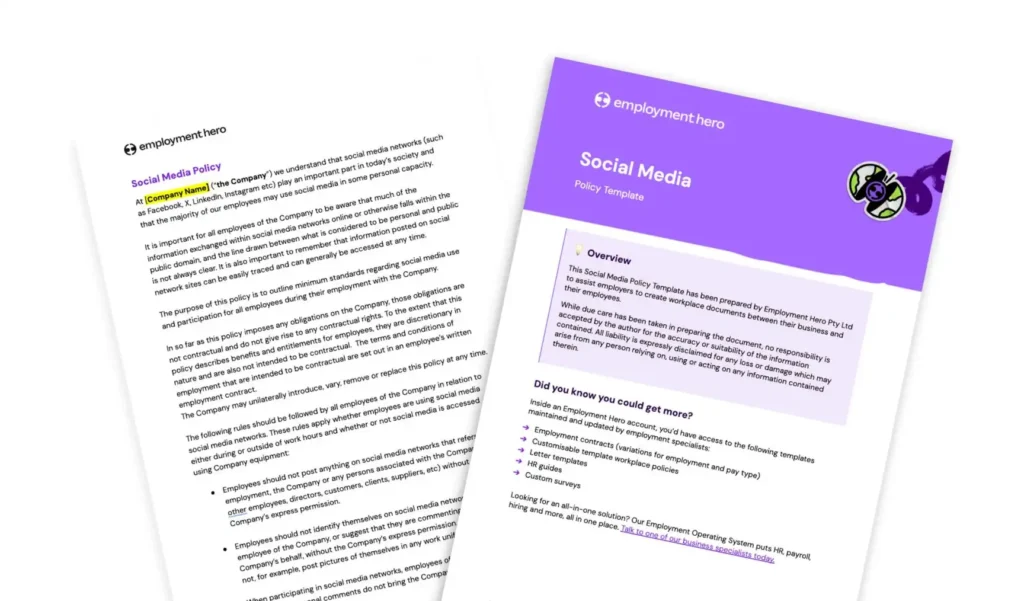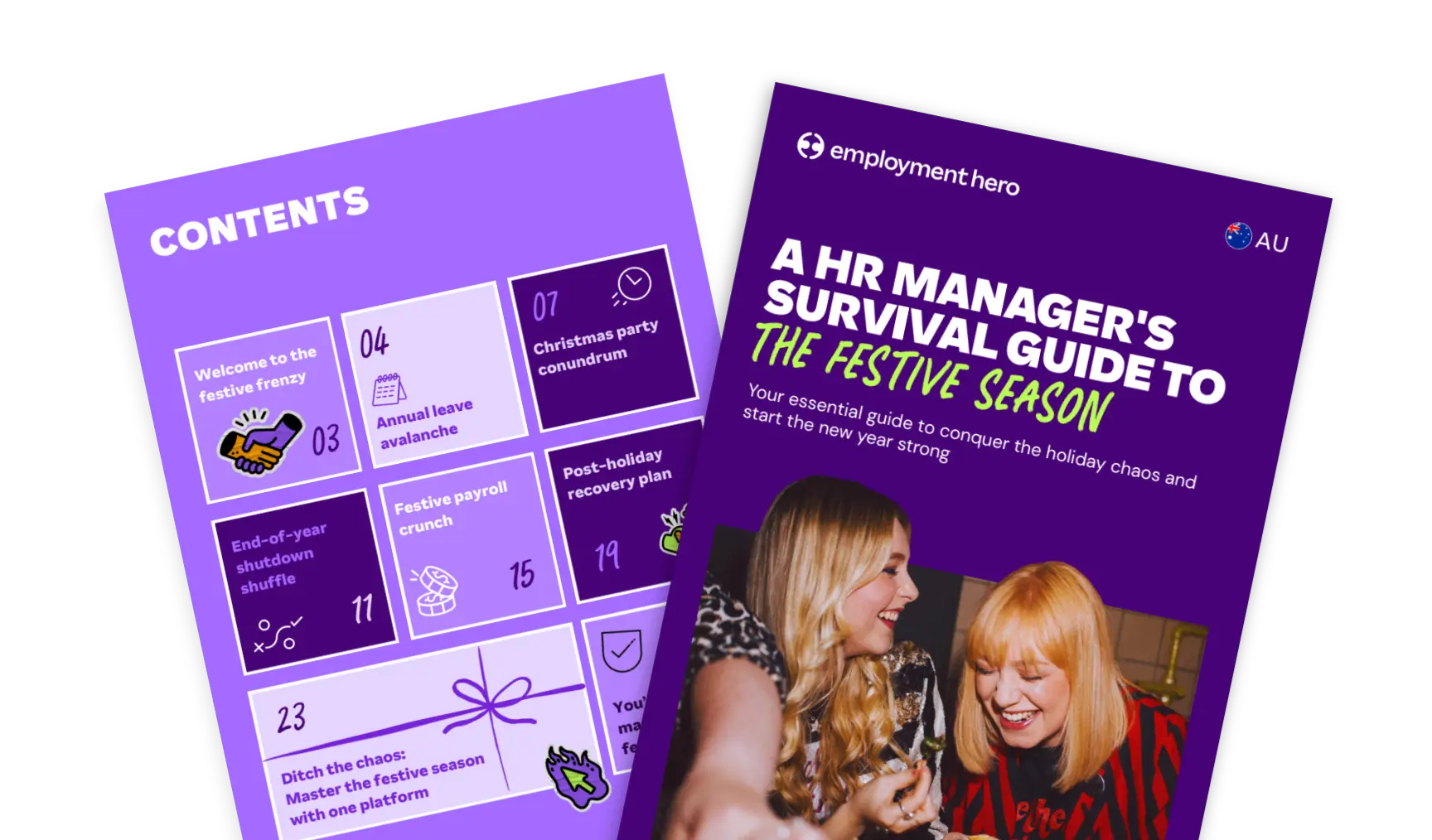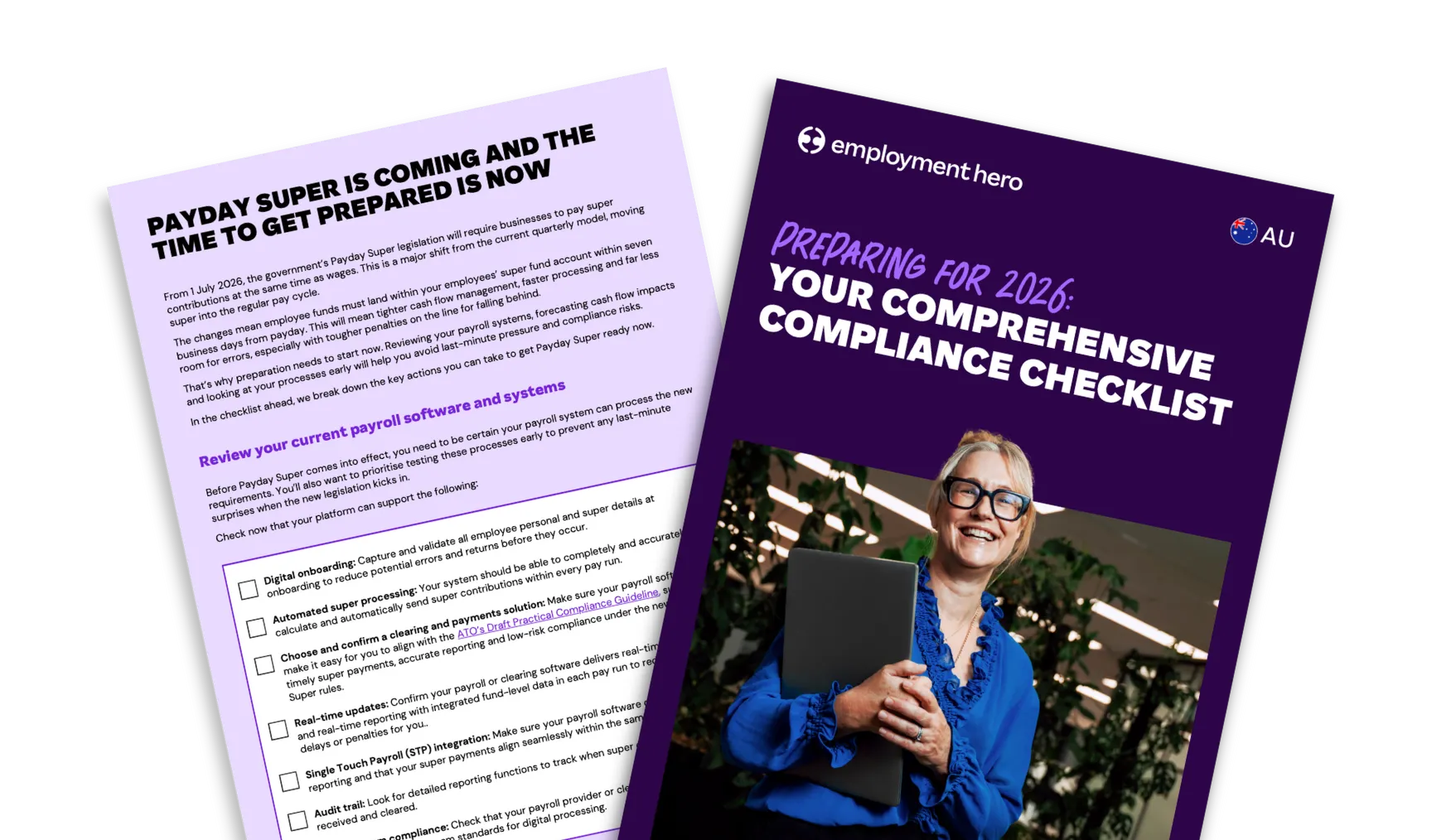Workplace social media policy template and guide
Published
Workplace social media policy template and guide
Social media can be a great way for employees to connect, but it can also create risks if expectations aren’t clear.
A workplace social media policy sets out how employees should represent themselves and your business online. Use this template to provide clear guidance, protect your brand and support a positive, respectful workplace culture.

How can this social media policy template help?
A social media policy is a practical document that helps manage how your team uses social media. By providing clear guidelines for everyone, it protects your brand, supports professional behaviour and gives your employees confidence to engage online responsibly.
This social media policy template can help you with the following:
- Maintain your brand identity consistently across all channels
- Treat legal and regulatory sensitivities with awareness
- Mitigate security breach risks
- Manage potential PR crises (and how to act quickly if one does happen!)
- Be upfront with your employees regarding their own social media responsibilities
- Encourage your employees to own and amplify your brand’s message
What is a social media policy for employees?
A social media policy for employees is a set of guidelines and rules that outlines how employees should behave on social media platforms when representing their employer or discussing matters related to their workplace.
It provides guidance on what’s considered acceptable and unacceptable behaviour on social media channels and ensures that employees are aware of the potential risks associated with their online activity. It’s also used to safeguard the brand’s reputation, security, privacy and legal interests.

What is the purpose of a social media company policy?
Most people use social media every day in some shape or form. Some employees often use both their personal social accounts and corporate social accounts for various reasons. This might be to share about their achievements at work or give others a sneak peek into a ‘day in the life’ of their roles at work.
Having a social media company policy provides a framework for responsible social media use that aligns with the organisation’s values and objectives. It also serves various purposes, such as:
Protecting the company’s reputation
Employees have the opportunity to represent your company across social media, but their posts, comments, or interactions can impact your brand and reputation.
A social media policy provides guidance on what’s defined as appropriate content and behaviour, while preventing employees from posting confidential, sensitive, or damaging content.
Maintaining compliance
Having a crystal clear social media policy can help ensure that employees comply with laws, regulations and industry standards related to social media use, such as data protection and privacy laws.
This helps to prevent any legal issues such as privacy violations, defamation, or infringement of intellectual property rights.
Clarifying expectations
A social media policy sets expectations for employee behaviour on social media platforms, establishing clear definitions of what is considered acceptable or unacceptable content and what can or can not be shared.
It also provides transparency and ensures employees take accountability over anything they post on their personal or corporate social media profiles.
Encouraging responsible social media use
It’s crucial to educate employees on the importance of responsible social media use and the potential consequences of inappropriate behaviour, such as disciplinary action.
This can be done through your social media policy. This helps prevent any sensitive information or important documents from being leaked unknowingly.
Supporting employee advocacy
Besides educating and establishing guidelines, having a social media policy in place can help encourage employees to promote the company’s products, services or culture on social media channels in a way that shows the organisation’s goals and values.
Social media plays a big role in providing jobseekers with the opportunity to gain direct insight into your company culture. It’s incredibly important in helping you build your employer brand.
With so many people using social media platforms like LinkedIn to find new roles, it’s important you use it to highlight your employer value proposition (EVP) and that your employees know how to do so appropriately.

What should you include in a company social media policy?
A company social media policy typically includes the following elements:
Purpose and scope
The social media policy should clearly state its purpose and the social media channels it applies to, such as Facebook, X, LinkedIn, Instagram, Youtube, TikTok and others.
Responsibilities
The policy should clearly outline the roles and responsibilities of employees, managers, and the organisation when it comes to managing social media accounts. This ensures everyone knows who is responsible for maintaining standards and following the guidelines.
Code of conduct
The policy should provide guidance on the acceptable use of social media platforms and what is considered inappropriate behaviour, such as sharing confidential information or making rude comments about colleagues or customers.
Personal use
Clarify whether employees are allowed to use social media during work hours, what kind of personal content they can share online and what topics or content are strictly forbidden from being posted in the policy.
Monitoring and enforcement
Explain how the organisation will monitor employees’ social media activity, the number of warnings they’ll receive and what consequences employees may face for violating the policy.
This way, they gain full clarity and understanding over what is expected of them, and the resulting consequences should they fail to adhere to it.
Once you’ve finalised your social media policy, it’s important to ensure that your employees read and acknowledge it, especially those in your social media team.
You should also remember that the social media landscape changes often. Privacy rules and regulations are constantly updated and new ones are always introduced. Trends also come and go very quickly, so you want to put in place a regular cadence of updating your social media policy accordingly.

Common social media policy examples
Here are some clauses to get you started with crafting your social media policy:
Usage of company’s social media accounts
- Ownership: The company owns the social media accounts and the content posted on them. Employees should not create company social media accounts without prior approval.
- Authorisation: Only authorised employees should have access to company social media accounts, and they should use them in a way that aligns with the company’s values and goals.
- Branding and marketing: All content posted on company social media accounts should adhere to the company’s branding and marketing guidelines.
- Community management: Employees who are authorised to use company social media accounts should respond promptly to customer inquiries or comments.
- Confidentiality: Employees should not post confidential or proprietary information on company social media accounts.
Usage of personal accounts
- Personal views: Employees should make it clear that their personal social media accounts represent their personal views and not those of the company.
- Professional conduct: Employees should maintain a professional tone and avoid posting any content that is offensive, discriminatory, or defamatory, even on their personal accounts.
- Conflict of interest: Employees should disclose any conflict of interest when posting about the company or its products or services on their personal accounts.
- Branding and marketing: Employees should not use the company’s logo or other intellectual property on their personal accounts.
- Confidentiality: Employees should not disclose confidential or proprietary information about the company or its clients on their personal social media accounts.
Challenges you may face when implementing a social media policy
Implementing a social media policy may be met with some resistance or challenges. Some challenges that might crop up include:
Employee resistance
Some employees may perceive having a social media policy as a restriction of their personal freedoms and may be resistant to its implementation.
To address this, companies should communicate the reasons for the policy and the benefits of responsible social media use so they can better understand the rationale and purpose.
Lack of awareness or training
Some employees may not be aware of the potential risks and consequences of inappropriate social media use. Alternatively, they may not have the necessary skills or knowledge to use it responsibly.
Employers can provide training and education on what positive social media use entails and any potential case studies that employees can learn from.
The changing nature of social media
Social media platforms and technologies are constantly evolving. You may find it challenging to keep up with the latest trends and updates because the industry is changing at such a rapid pace. Like we’ve mentioned previously, companies should review and update their social media policy regularly (either bi-annually or annually) to reflect recent changes.
Enforcement
It can be challenging to enforce a social media policy, especially in cases where the policy has been violated. Have a clear disciplinary process in place for any violations and ensure that all employees are aware of the consequences of non-compliance.
What happens if employees breach the policy guidelines?
If employees breach policy guidelines, the consequences can vary. Depending on the severity of the violation and the company’s disciplinary process, you can choose to issue them with a:
- Verbal warning: For minor violations such as posting negative comments about the company, the employee may receive a verbal warning from their direct manager or HR representative.
- Written warning: For more grave violations such as posting defamatory content about the company or its employees, the employee may receive a written warning that outlines the specific violation and consequences for future violations.
- Termination: In cases of serious or repeated violations, the employee may face termination of their employment.
In addition to these consequences, you should also take corrective action to mitigate the damage caused by the violation, such as removing offending posts or addressing customer complaints.
It’s also advisable to send the offending employee for regular training and education on recommended social media use, so they are able to learn from their mistakes and prevent any further violations in the future.

Manage workplace policies easily with Employment Hero
Now that you know all about the importance of a social media policy, why not download our social media policy template and get started on crafting your own? You can add to it, edit it, and change clauses, it’s all up to you.
If you’re on a mission to build a positive company culture, workplace policies are important. And if you need HR policies written by experts? We’ve got you covered.
Our all-in-one Employment Operating System has tonnes of policies that are ready to go when you are. All you have to do is choose which policies apply to your business and personalise them accordingly.
What’s more, you can assign the relevant policies to each employee and have them acknowledge each document digitally, anywhere and anytime. It’s fuss-free and there’s no paperwork involved. Managing workplace policies will never be a pain again.
The information in this article is current as at 30 August 2025, and has been prepared by Employment Hero Pty Ltd (ABN 11 160 047 709) and its related bodies corporate (Employment Hero). The views expressed in this article are general information only, are provided in good faith to assist employers and their employees, and should not be relied on as professional advice. Some information is based on data supplied by third parties. While such data is believed to be accurate, it has not been independently verified and no warranties are given that it is complete, accurate, up to date or fit for the purpose for which it is required. Employment Hero does not accept responsibility for any inaccuracy in such data and is not liable for any loss or damages arising directly or indirectly as a result of reliance on, use of or inability to use any information provided in this article. You should undertake your own research and seek professional advice before making any decisions or relying on the information in this article.
Before you download the template, we just need some details:
Related Resources
-
 Read more: HR Managers: Don’t just survive the festive season, master it
Read more: HR Managers: Don’t just survive the festive season, master itHR Managers: Don’t just survive the festive season, master it
Make year-end easier: manage leave, payroll, parties and shutdowns with confidence. Get practical tips for Australian SMEs. Download the free…
-
 Read more: Preparing for 2026: Your Compliance Checklist
Read more: Preparing for 2026: Your Compliance ChecklistPreparing for 2026: Your Compliance Checklist
Get your business ready for the 1 July 2026 changes. See practical steps for Payday Super, cash flow planning and…
-
 Read more: Monthly business budget template for employers
Read more: Monthly business budget template for employersMonthly business budget template for employers
Plan your monthly income and expenses with our free monthly business budget template. Download today to track cash flow and…























